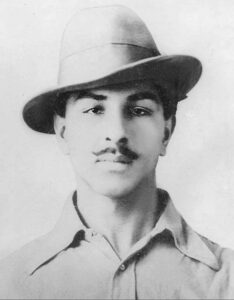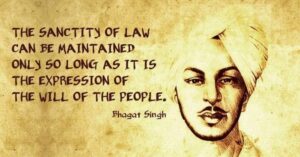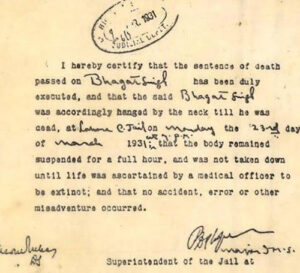
Bhagat Singh is one of the most famous revelationary in Indian Freedom Struggle and is known as Shaheed Bhagat Singh (Shaheed means martyr). He gave a new direction to the revolutionary movement and a goal beyond the elimination of the British. A clarity of vision and determination of purpose distinguished Bhagat Singh from other leaders of his time.
- Born on 28 September 1907, in Lyallpur district of Panjab Province of British India (Now Pakistan). His family was actively involved in the freedom struggle.
- He studied European revolutionary movement and was widely attracted to the socialism.
He realised that the overthrow of British rule should be accompanied by the socialist reconstruction of Indian society and for this political power must be seized by the workers.
- The incident of the Jalianwala Bagh massacre in 1919 increased his hatred towards the British Rule. He was 12 years old then.
He even collected the blood mixed soil and kept it as a memento that would serve as a motivation for him for his entire lifetime.
- In 1923, Bhagat Singh won an essay competition set by the Punjab Hindi Sahitya Sammelan. This got the attention of the members of the organization including Prof. Bhim Sen Vidyalankar, its General Secretary. He read a lot of poetry and literature written by Punjabi writers and Allama Iqbal was his favourite poet.
- Inspiring from the call of Mahatma Gandhi to participate in Non-cooperation movement, Bhagat Singh left the school and joined the movement in 1921.
- However, in 1922, when Gandhiji suspended the Non-cooperation movement against violence at Chauri Chaura in Gorakhpur, Bhagat Singh was greatly disillusioned. His faith in non-violence weakened and he came to the conclusion that armed revolution was the only practical way of winning freedom.
- Bhagat Singh joined in the Hindustan Republican Association at Kanpur. After the arrest of the leading figures of the association, he along with the youths formed Hindusthan Socialist Republican Association.
- He circulated newspapers and notices in different languages to make people more aware about his motives.
- In 1928 he attended a meeting of the revolutionaries in Delhi and came into contact with Chandrasekhar Azad. They formed Hindustan Samajvadi Prajatantra Sangha with the objective of establishing a republic in India by means of an armed revolution.

- In 1928, the British government set up the Simon Commission to report on the political situation in India. Some Indian political parties boycotted the Commission because there were no Indians in its membership, and there were protests across the country. When the Commission visited Lahore on 30 October 1928, Lala Lajpat Rai led a march in protest against it. Police attempt to disperse the large crowd resulted in violence. The superintendent of police, James A. Scott, ordered the police to lathi charge (use batons against) the protesters and personally assaulted Rai, who was injured. Rai died of a heart attack on 17 November 1928. Doctors thought that his death might have been hastened by the injuries he had received. When the matter was raised in the Parliament of the United Kingdom, the British Government denied any role in Rai’s death.
Shaheed Bhagat Singh respected and idolized Lala Lajpat Rai. So when Lala Lajpat Rai succumbed to injuries by the infamous lathi-charge led by superintendent of police, James A. Scott while protesting against the Simon Commission, Bhagat Singh decided to take revenge and kill Scott. He ended up killing John P. Saunders, an Assistant Superintendent of Police.
- Influenced by Auguste Vaillant, a French anarchist who had bombed the Chamber of Deputies in Paris, Singh’s plan was to explode a bomb inside the Central Legislative Assembly. The nominal intention was to protest against the Public Safety Bill, and the Trade Dispute Act, which had been rejected by the Assembly but were being enacted by the Viceroy using his special powers; the actual intention was for the perpetrators to allow themselves to be arrested so that they could use court appearances as a stage to publicise their cause.
- On 8 April 1929, Singh, accompanied by Batukeshwar Dutt, threw two bombs into the Assembly chamber from its public gallery while it was in session. The bombs had been designed not to kill, but some members, including George Ernest Schuster, the finance member of the Viceroy’s Executive Council, were injured. The smoke from the bombs filled the Assembly so that Singh and Dutt could probably have escaped in the confusion had they wished. Instead, they stayed shouting the slogan “Inquilab Zindabad!” (“Long Live the Revolution”) and threw leaflets. The two men were arrested and subsequently moved through a series of jails in Delhi.
On October 7, 1930, Bhagat Singh, Sukh Dev and Raj Guru were awarded death sentence by a special tribunal. Bhagat Singh wrote a letter to Viceroy Lord Irwin when he was in prison asking him to execute them not by hanging but by firing squad. But his plea was rejected and he was hanged on March 23, 1931, when he was only 24 years old.

Bhagat Singh’s contribution to the nation is highly remembered. He wanted his death to be the inspiration of thousands of youth at that time and for the generation to come.
He was hit with a bullet, yet he stayed quiet…..read more

